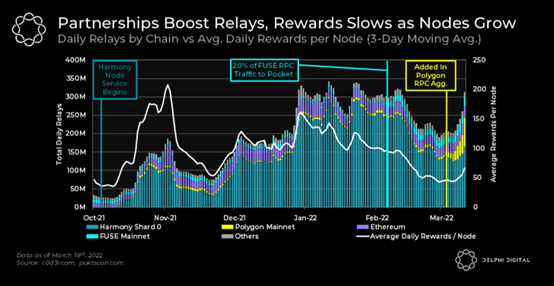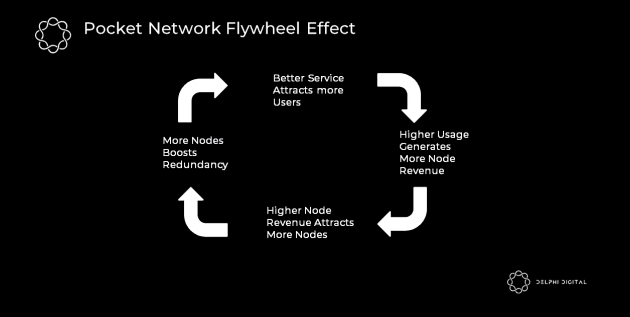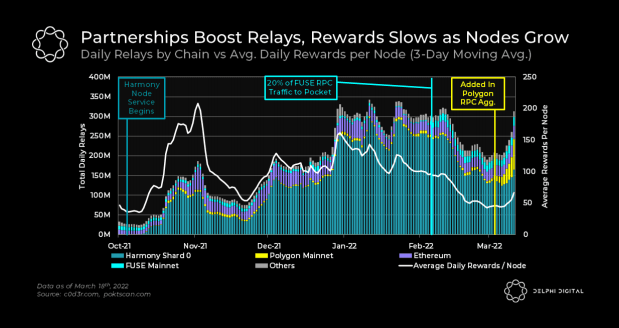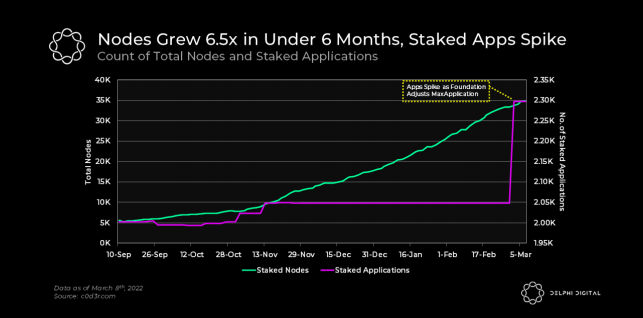
first level title
Main points of this article
Infura has achieved great success since its inception. It is estimated that in 2020, Infura will handle an average of 10 billion requests per day, which is 36 times that of Pocket Network's average daily relay of 277 million this year. From this point of view, although Pocket Network still has a long way to go, it also shows that the market has a lot of room for development.
While Infura users have easy access to on-chain data, it can present a centralized point of failure. Service is subject to disruption/censorship, for political and regulatory reasons in addition to technical incidents. Infura's outage in 2020 and its recent outage in Venezuela are good examples. After Pocket nodes prove their work to the network (the number of relays served), they can mint new POKT, increasing the token supply. Correspondingly, participants must pledge POKT to participate in network activities. Over the past 6 months, the total supply of POKT has inflated by 44%, while the circulating supply has decreased by 24%.
Every time the Pocket network becomes the first choice for a new ecosystem/new chain, its relay count increases dramatically. In just two days after Pocket joined Polygon Studios' RPC aggregator, the number of daily relays increased by approximately 44%.
secondary title

Main Responsibilities of Pocket Network Nodes
To run a node, at least 15,000 POKT must be staked. The node has two main functions:
1. Verify the Pocket blockchain (POKT top 1000 nodes)
2. Provide relay services for users/applications
Every time a relay is processed, the node will receive a predetermined amount of POKT rewards, which will be divided into 3 parts:
1. 89% are allocated to nodes that provide relay services
2. 1% is allocated to the verification nodes that generate blocks
3. 10% go to Pocket DAO
Nodes can be jailed and hacked for misconduct such as:
1. Nodes have downtime
2. Double-sign blocks (threat to network security)
These measures are designed to ensure that all nodes are good participants in the ecosystem and prevent malicious behavior.

secondary title
How the Pocket Network Works
To participate in Pocket network activities, the demand side (users/applications), similar to the supply side (nodes), must stake POKT. The more POKT an application stakes, the more relays it can request on the network.
Pocket's security comes from two mechanisms:
1. The Pocket Network implements a closed relay proof mechanism, where the work of relayers is verified through the network using zero-knowledge range proofs. This mechanism cryptographically ensures that relayers cannot make up the number of relays they serve. Once the consensus confirms the validity of the proof, tokens are minted into the node’s wallet in proportion to the number of relays served.
2. If an application believes that a relayer is relaying inaccurate data, it can initiate a challenge, which can slash the relayer's staked tokens.

flywheel effect
 Pocket Network has a unique flywheel effect. The continuous improvement of the service can attract more users. More users will generate more relay services, which will then mint more POKT rewards for running nodes. Higher POKT rewards increase node profitability, incentivizing more people to run nodes. With more nodes, the redundancy of Pocket Network can be improved and better service can be brought. This keeps the flywheel effect going.
Pocket Network has a unique flywheel effect. The continuous improvement of the service can attract more users. More users will generate more relay services, which will then mint more POKT rewards for running nodes. Higher POKT rewards increase node profitability, incentivizing more people to run nodes. With more nodes, the redundancy of Pocket Network can be improved and better service can be brought. This keeps the flywheel effect going.
From the graph above, we can see the 3-day moving average of the total number of daily relays versus the average reward per node. Harmony Network holds a 46% share of relays served. This is because Harmony includes Pocket's RPC endpoint as part of its default public endpoint. It is followed by Polygon and Ethereum with 34% and 10% respectively.
It can be seen that the first growth point of Pocket starts from providing relay services for Harmony in October 2021. This resulted in a 6-fold increase in the daily relay volume on the Pocket Network, from about 50 million before to a peak of about 300 million. This will be followed by integration with Fuse in February 2022, which will also have a positive impact, although not as great as Harmony. Finally, Polygon's relay count has skyrocketed following the recent integration of Pocket Network with Polygon's RPC aggregator. In just two weeks after integrating with Polygon, the number of daily relays increased by 44%, which brought Pocket Network to an all-time high of 408 million daily relays on March 18, 2022.
A key point is that the growth in demand for the Pocket is highly correlated with industry developments. Whenever Pocket becomes the go-to choice for a new ecosystem, its relay count increases dramatically. The next new public chain expected to have Pocket as one of its default RPC providers is EVMOS. Once EVMOS gets back on track from its recent missteps, it will provide a new source of demand for Pocket.
In the graph above, we also notice that the rewards for the nodes have dropped. The main reason for this is the increase in the total number of nodes. As relays increase, so does the POKT reward, which leads to an increase in the supply side of the market. As more and more nodes join the network, the reward per node starts to decrease, which was about 40 POKT/node/day before Polygon integration.
Here are 3 main reasons why the daily POKT rewards for recent nodes have decreased:
1. More nodes add Pocket to the network, resulting in a decrease in the rewards of each node.
2. Harmony's relay has been declining since March 7, 2022, probably due to the slowdown of DeFiKingdoms, which bring a lot of traffic to Harmony.
 secondary title
secondary title
challenges and opportunities
challenges and opportunities"low code"or"or"no code
Based on the spirit of decentralization, Pocket DAO should continue to motivate its members and third parties to provide developers with a better platform experience and lower the barriers to launching, monitoring and scaling web3 applications. Pocket has more than $50 million in funds (denominated in POKT) that can be used for support and incentives to accelerate development.
secondary title
POKT recent performance
first level title
Summarize
Summarize
As with all networks, centralized and decentralized solutions are used interchangeably. In order for Pocket Network to be a practical solution for web3 applications, it must offer a better product or service than its centralized counterparts such as Infura. Reliability and cost are two of the most important considerations for any application developer when it comes to blockchain connectivity.reliability:
Pocket Network incentivizes a growing network of RPC nodes to handle on-chain data requests from web3 applications. It does this by creating an efficient two-sided market between 1) developers (requesting on-chain data for their applications) and 2) relayers (who want to be compensated for running blockchain nodes), enabling on-chain Data request and access. The Pocket network consists of tens of thousands of service nodes, reducing the risk of network failure. If a particular node on the network is unable to service user requests, those requests are automatically rerouted to other nodes, allowing for 100% uptime reliable service.cost:
Another way to attract app developers is to offer similar services at a lower cost. Centralized companies like Infura and Alchemy charge a monthly service fee. To stay competitive, Pocket Network has a built-in mechanism (BaseRelayPerPOKT) that adjusts the dollar cost ($) per relay to be on par with the cheapest competitor. Without this adjustment, the cost per relay would increase as the price of POKT increases. Conversely, when the price of POKT increases, Pocket Network will increase the number of relays that each staked POKT can call. This way, the dollar cost per relay remains stable even as the POKT price fluctuates.
Pocket Network's staking model converts recurring expenditures into capital expenditures with recoverable value. The upfront costs required to stake POKT are similar to a company investing in its own infrastructure to build and expand its business operations. App developers pay Infura a monthly fee to use its API services, and the money is spent. If they decide to use a different provider, they won't get back the money they've already spent. And if app developers decide not to use the Pocket Network, they can sell their POKT on the open market and recover at least some of their upfront capital costs. Even if the price of POKT drops by 50-60% over its lifetime, developers can still recoup some of the initial cost. If the price of POKT rises during its lifespan, the developers not only get all the services, but also profit from their initial capital expenditure.